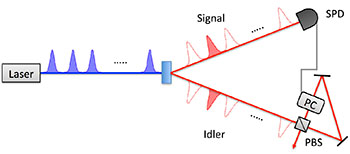
In a time-multiplexed SPDC system, detection of a signal photon “heralds” the presence of an entangled idler photon, which is captured for later recovery (through polarization switching) in an optical storage cavity. PBS = polarization beam splitter; PC = Pockels cell.
A major stumbling block to optical quantum information processing (QIP) has been the lack of a good source of single photons—“good,” in this case, defined as a source that pumps out photons both efficiently and deterministically. Scientists in the U.S. and South Korea have now reported significant improvements to one standard technique that can boost single-photon probabilities in narrow time slots nearly sixfold (Optica, doi: 10.1364/OPTICA.2.001010). The team believes that, with some additional development, the technique could enable construction of near-deterministic single-photon sources, clearing a longstanding logjam in scaling up QIP.
Generating heralded photons
The technique in question goes by the lengthy title of spontaneous parametric down-conversion (SPDC). In SPDC, an entangled photon pair is created when a laser source passes through a nonlinear crystal. The detection of one of the entangled photons “heralds” the presence of the other. But, while the process can generate single photons with high efficiency, it is inherently probabilistic, rather than producing single photons “on demand” as QIP at scale would require.
While there’s no way around the probabilistic nature of SPDC, one can in principle make the process nearly deterministic by boosting the probabilities of finding single photons in a given time slice—an approach called time multiplexing. Under the approach, first discussed more than a decade ago, a laser source, pumped into a nonlinear crystal, generates entangled “signal” and “idler” photon pairs; the signal photon is sent to a detector, while the heralded idler photon is shunted into an optical storage loop or cavity. In principle, that means that the single idler photon can be recovered at a later time chosen by the user—an “on-demand” system.
Overcoming experimental hurdles
The theory behind time-multiplexed SPDC sounds simple and powerful—but, as with so much in QIP, the devil is in the details. For example, storing the single photons in the cavity for long periods tends to attenuate them, leading to high losses with standard optical components. And pushing single-photon probabilities close to deterministic levels requires multiplexing across a large number of time slots in a given cycle, something that has been hard to achieve in the past.
The U.S.-South Korea team, led by scientists at the University of Illinois, Urbana-Champaign (USA), attacked those problems at the source. At the heart of the group’s effort was an improved design of the optical delay line that included a low-loss Herriott cell. The new design enabled long enough delay times that the team was able, effectively, to select the time slice containing the last-detected signal photon, and to move only the corresponding idler photon into the storage cavity. The approach thus minimizes the interval between storage of the single photon and the output time window, thereby reducing losses by attenuation. Another improvement was the use of faster polarization switches to allow the cavity’s parameters to be finely adjusted.
The upshot: The team was able to improve the probability of obtaining a heralded single photon in a given time window, to the area of 39 percent—a sixfold increase over non-multiplexed SPDC sources—without a corresponding increase in unwanted multiphoton events. Further, with feasible improvements in collection and detection efficiencies and additional, attainable reductions in cavity losses, the scientists believe that the single-photon probability could rise to as high as 80 percent. That’s a level that, in their view, would “enable a periodic and near-deterministic single-photon source that will be a critical component for larger-scale optical QIP applications.”
